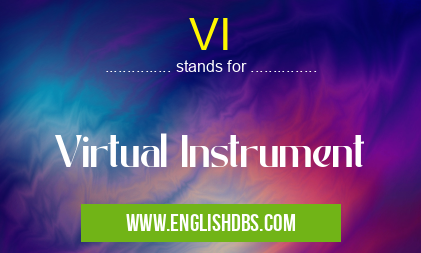What does VI mean in SOFTWARE
Virtual Instrument (VI) is a term used in computing to refer to software that emulates an instrument or other electronic device. VIs are typically used to generate sound on computers and mobile devices, as well as for audio processing. They can be used for both digital and analog signals, making them useful for a variety of tasks.

VI meaning in Software in Computing
VI mostly used in an acronym Software in Category Computing that means Virtual Instrument
Shorthand: VI,
Full Form: Virtual Instrument
For more information of "Virtual Instrument", see the section below.
Essential Questions and Answers on Virtual Instrument in "COMPUTING»SOFTWARE"
What is a Virtual Instrument?
A virtual instrument (VI) is a software application that emulates the operation of a traditional musical instrument. VIs are designed to run on personal computers, tablets, or other electronic devices and enable musicians to create and perform music without the need for expensive physical equipment. Additionally, VIs offer an increased level of control over traditional instruments, allowing for more creative exploration.
How does a Virtual Instrument work?
VIs interpret instructions from midi controllers, such as notes and chords, into sound variations. Typically, these sounds are generated using synthesis methods from within the software itself. The sounds can then be manipulated further with sliders and knobs which control elements such as volume, pitch, envelope shaping, filtering and effects such as distortion and delay.
Is there any difference between using a hardware-based or software-based instrument?
Yes. Hardware-based instruments typically require the purchase of separate components such as amplifiers and speakers in order to create sound whereas software-based instruments generate their own sound electronically without any external hardware requirements. Additionally, hardware-based instruments may require more maintenance than software-based instruments due to wear and tear on parts as well as regular upkeep being required for optimal performance.
What are some advantages of using a Virtual Instrument?
There are many benefits associated with VIs including portability, affordability, and versatility when compared to traditional musical instruments. VIs also take up less physical space than their real world counterparts making them ideal for smaller areas or limited storage facilities. In addition to this users have access to an extensive library of both classic and modern sounds which can be tailored to create unique backing tracks quickly and easily.
Are Virtual Instruments suitable for live performances?
Yes! Many professional musicians use VIs in live performances as they offer great versatility in terms of sound design when compared to their hardware counterparts. As previously mentioned VIs also have access to an expansive library of sounds enabling users to mix different audio elements together during their performance creating dynamic audio experiences.
Do I need any extra equipment to use a Virtual Instrument?
Not necessarily; most modern computers come equipped with necessary ports allowing you to connect controller keyboards directly into your machine via USB or MIDI cables meaning no extra equipment is needed apart from your computer itself. If however you wish to monitor your playing output through external speakers then some additional audio equipment would be needed.
Will I need special training/skills in order to produce professional sounding music with Virtual Instruments?
No; whilst familiarity with certain aspects of music production will certainly help users improve their creations it is not mandatory by any means and even beginners can achieve impressive results in no time at all thanks in part to the onboard tutorials contained within many VI programs available today.
Does it take long time for me becoming familiar with my first Virtual Instrument?
This really depends on how much time one is willing dedicate towards learning the nuances of their chosen instrument; generally speaking however most basic features can be picked up relatively quickly so mastering fundamentals is possible within a relatively short period of time depending upon individual commitment levels.
What are some tips for improving my Virtual Instrument sound design skills?
Some key areas worth focusing on include understanding synthesis techniques (for example subtractive/additive forms), experimenting with different effects parameters (such as reverb/delay etc.), being able utilize all available parameters within each virtual instrument module efficiently (for example filter cutoff/resonance etc.) and lastly familiarization with various mixing techniques (such as sidechain compression).
What are some popular DAWs that support Virtual Instruments?
Popular options include Logic Pro X, Ableton Live 9 Suite , FL Studio 20 Producer Edition , Avid Pro Tools 12 , Cubase Pro 9/10 , Reason 11 , Bitwig Studio 3 and Reaper 5.
Final Words:
A Virtual Instrument (VI) is an incredibly useful tool for musicians and sound designers alike; it provides users with endless possibilities when creating soundscapes and musical compositions. With its wide range of applications and customizability features available through software programs such as Ableton Live or Logic Pro X, there's something out there for everyone who wants to explore the vast potentials of virtual instruments in their work!
